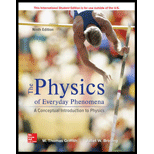
Concept explainers
Whether a chemical element is same as a chemical compound.
Answer to Problem 1CQ
A chemical element is not same as a chemical compound.
Explanation of Solution
An element is defined as any substance that contain only one type of atom. They are made of atoms which are the smallest particles that has any properties of the elements. Elements are arranged in the periodic table.
Compounds are substances formed by combination of elements. There are different types of compounds such as metallic and non-metallic. The examples of compounds are water, sugar, ammonia etc.
Even though chemical compounds are combination of chemical elements, the properties of compounds can be quite different from that of the constituent elements. The same elements can be combined in different ways to form different compounds.
Conclusion:
Thus a chemical element is not same as a chemical compound.
Want to see more full solutions like this?
Chapter 18 Solutions
Physics of Everyday Phenomena
- According to the modern atomic theory, how many electrons are found in n = 2?arrow_forward3. An atom consists of a. one nucleus and only one electron b. one nucleus and one or more electrons c. protons, electrons, and neutrons d. answers (b) and (c)arrow_forward1. (i) What is active element? Give two examples of both active and passive elements. (ii) What is 1 eV? 2arrow_forward
- 61.) While researching for her class presentation, karen has read that natural occuring Gallium consists of 60% Ga (atomic mass=68.911) and 40 % of Ga(atomic mas= 70.9311). What is the average atomic mass of Ga?arrow_forwardWhich model of the hydrogen atom, the Bohr model orthe quantum-mechanical model, predicts that the electronspends more time near the nucleus? Explainarrow_forward14 5) e 238 u→ ? Th + 90 92 주H+ 주 %3 6m+-arrow_forward
- How does the wave model of electrons orbiting the nucleus account for the fact that the electrons can have only discrete energy values? Question options: The wave model accounts for the types of orbitals an electron may occupy, not it's energy levels. Electrons are only able to vibrate at particular frequencies. The energy values of an electron only occur where its wave properties and probability clouds are mutually reinforcing. When an electron wave is confined as standing wave, it is reinforced only at particular frequencies.arrow_forward7. If the radius of the nucleus R = 1.2x 10^-13 cm, and known it is 1 fermi = 10^-13 cm, the nuclear radius of the 12C carbon atom is a. 1.2 fermi b. 2.7 fermi c. 3.6 fermi d. 1.7 fermi e. 2.2 fermiarrow_forwardElement X has a half-life of 6 hours. How much of X remains from a 64 kg sample after one day? A. 11 kg B. 22 kg C. 4 kg D. 16 kg E. 44 kgarrow_forward
- 29. If H3 11, 6 — 23 , в-Б — 30, then a-6 is : %3D (а) 10 (b) 20 (с) 30 (d) 40arrow_forwardYour friend says that what makes one element distinct from another is the number of electrons about the atomic nucleus. Do you agree wholeheartedly, partially, or not at all? Explain.arrow_forwardConsider the atomic species: 146C, 126C and 15,N. Which ones have the same number of neutrons? a. None of them b. 126C and 15,N C. All three O d. 146C and 15,N e. 146C and 126Carrow_forward
 Horizons: Exploring the Universe (MindTap Course ...PhysicsISBN:9781305960961Author:Michael A. Seeds, Dana BackmanPublisher:Cengage Learning
Horizons: Exploring the Universe (MindTap Course ...PhysicsISBN:9781305960961Author:Michael A. Seeds, Dana BackmanPublisher:Cengage Learning College PhysicsPhysicsISBN:9781938168000Author:Paul Peter Urone, Roger HinrichsPublisher:OpenStax College
College PhysicsPhysicsISBN:9781938168000Author:Paul Peter Urone, Roger HinrichsPublisher:OpenStax College College PhysicsPhysicsISBN:9781305952300Author:Raymond A. Serway, Chris VuillePublisher:Cengage Learning
College PhysicsPhysicsISBN:9781305952300Author:Raymond A. Serway, Chris VuillePublisher:Cengage Learning Modern PhysicsPhysicsISBN:9781111794378Author:Raymond A. Serway, Clement J. Moses, Curt A. MoyerPublisher:Cengage Learning
Modern PhysicsPhysicsISBN:9781111794378Author:Raymond A. Serway, Clement J. Moses, Curt A. MoyerPublisher:Cengage Learning Principles of Physics: A Calculus-Based TextPhysicsISBN:9781133104261Author:Raymond A. Serway, John W. JewettPublisher:Cengage Learning
Principles of Physics: A Calculus-Based TextPhysicsISBN:9781133104261Author:Raymond A. Serway, John W. JewettPublisher:Cengage Learning Physics for Scientists and EngineersPhysicsISBN:9781337553278Author:Raymond A. Serway, John W. JewettPublisher:Cengage Learning
Physics for Scientists and EngineersPhysicsISBN:9781337553278Author:Raymond A. Serway, John W. JewettPublisher:Cengage Learning





